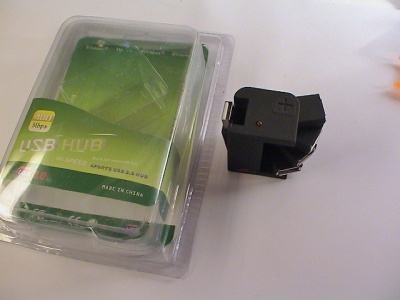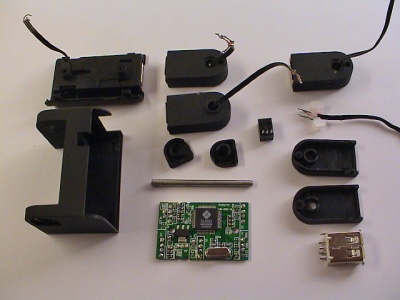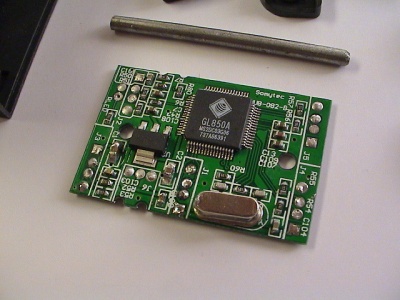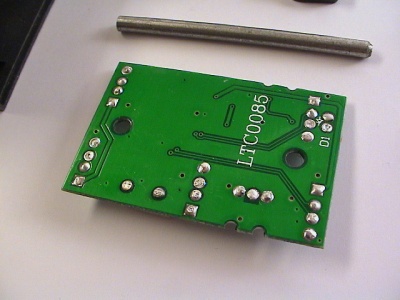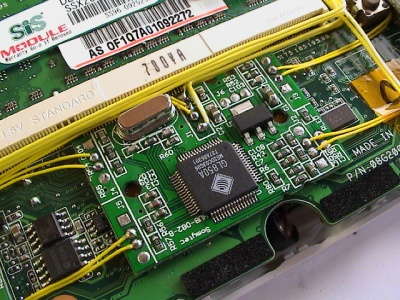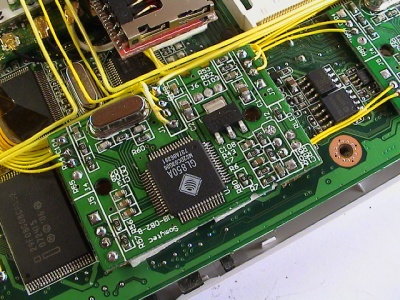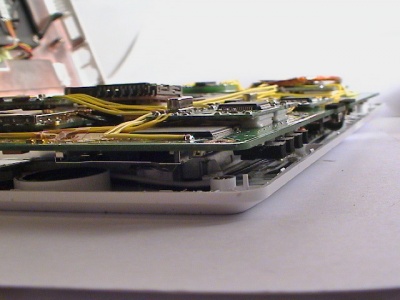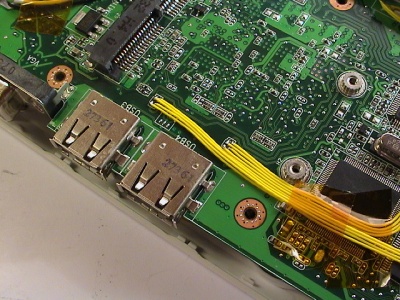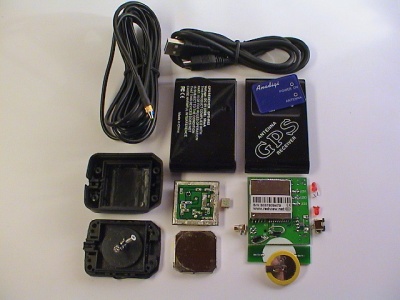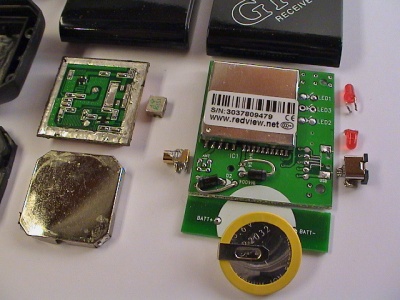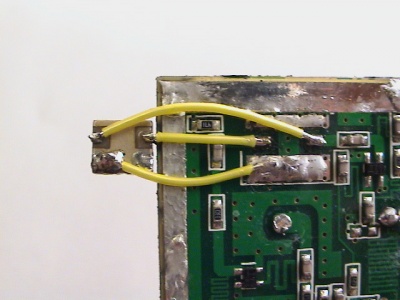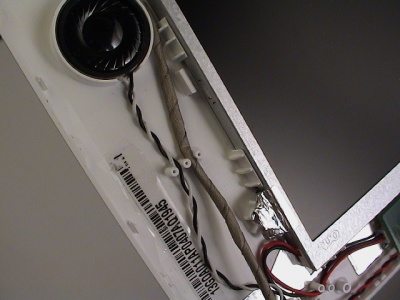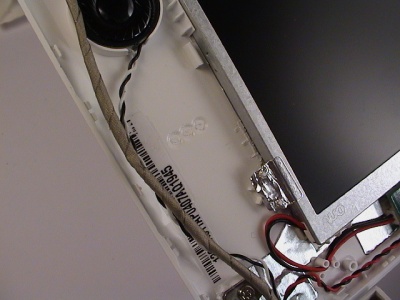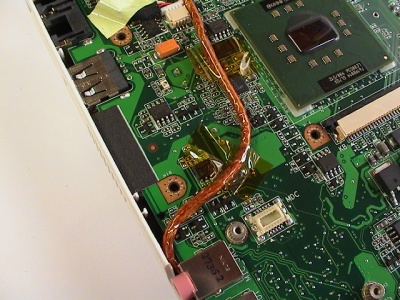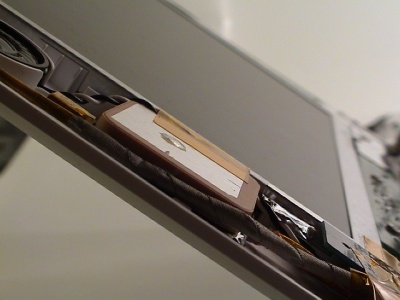Eee PC Internal Upgrades
USB hub
To install devices internally, more USB-connections are needed. I hooked into one of the regular USB-ports and routed the D+/D- signals from the southbridge/controller to a 4 port USB-hub. To make the port I hooked into work again, one of the 4 ports is connected back to the USB-port (Hub-to-USB-port and USB-port-to-HUB).
I installed 2 hubs this way to get enough ports and load balancing the bandwidth. Having two storage devices on the same upstream connection is not a good idea speed-wise when utilizing both at the same time.
The reason I choose to hook into the USB-port and leave the spare Mini-PCIe USB connection alone is that I want to:
- Be able to use Mini-PCIe cards based on USB later
- Disable the USB-ports in BIOS and disable all the new devices
- Not have the devices disabled if I used the webcam or wifi connections
More information about USB hubs over at Wikipedia.
Models
For the type of hub, I went for a as small as I could find. The one I found had four rotating USB connections and one upstream connection sticking out from its side.
It goes under various names, here are a few I found:
- Korea rotating USB hub
- Synapsis flexible hub
- And just " USB 2.0 Mini Rotating Hub"
There's also a model with integrated SD card reader. Mine uses a Genesys Logic GL850A chip.
Installation
After cracking the case open, I stripped all the unnecessary parts from the circuit board like the LED and external power connector.
Top and bottom:
For the position I chose to place the first hub directly under the touch pad, next to the memory slot. It fits nicely and the depth of the circuit board just right. It's placed in the middle of the Eee motherboard, allowing for short wires for the different peripherals.
The second hub is positioned over the SSD NAND flash chips.
The total height is still low enough that it's not touching the chassis.
I hooked into the data signals of one of the USB ports on the right-side. One of the ports on the hubs is used to hook up the USB port again.
Overview:
Power is routed from one of the 5v points and through the switch board. Ground is connected to the nearest point.
GPS with antenna
Wouldn't it be cool to have a Eee PC with a integrated GPS unit? Yes, certainly I thought. Doing some research, a DIY kit turned up on Ebay for a decent price. The bulk kit included a GPS unit, antenna with 3 meter cable and mmcx connector, plastic case, and screws. Suitable to be permanently installed in a boat or car.
The GPS board itself was quite big and I had to strip it down as much as I could. Removing the LEDS and two connectors was easy, getting the board shorter was a bit harder. The 3.6v standby battery could easily be mounted off the board, and cutting the side of the board freed up the dead space.
The antenna was the hardest and most critical part that had to be fitted outside the shielded chassis. Before ordering the kit I was hoping it would fit in the display, and guess what, it just did by a small margin. The crystal on the underside had to be moved to the side of the main antenna body. Hopefully the RF characteristic won't suffer to much.
To fit the antenna next to the display, I had to cut away three stubs holding the cables in place and one place of a placeholder for the display unit. None of these stubs are voiding the integrity of the display, it all fits and holds together as normal.
I stripped the outer insulation of the RG-58 coaxial cable and replaced it with Kaptop electronic tape instead. That made it less rigid and easier to fit.
Routing the webcam and speaker wires to make space was pretty easy, lots of slack. I fitted the coax cable first, then soldered the core and shielding to the antenna.
After re-adjustmenting and re-positioning the wires, it turned out pretty good I think. The webcam wire placed between the locking mechanism and antenna is not squeezed as it might look like.
Bluetooth
SDHC card reader
Flash drive
Power switch
- Integrated: Webcam, Wifi PCIe adapter, SD card reader, Sound card, Atheros eithernet, Atheros Mini-PCIe adapter
- USB hub: Bluetooth, SD card reader, GPS adapter, FM transmitter
Modem
The modem port on the Eee is stuffed with a piece of black foam and not used. The modem is not installed on any Eee machine but the internal connection points are still there. The modem card connected via a MDC v1.5 connection, and 12 pin header for the card and the 2 pin header to connect to the RJ-11 jack is still in place on all current 4G motherboards.
Asus is still providing the Windows driver for the Conexant 56K modem on their download site, look for Modem_XP.zip
The modem card can be found on various Dell, Acer, and Sony laptops. On Ebay the Conexant card can be found under these model numbers:
- Conexant 56K Modem RD02-D110
- M5804 (Dell part number)
Wifi
The wifi-card on the Eee is only 802.11b/g, not the latest draft-N. The card is can be easily changed by removing two screws and unmounting the card from the Mini-PCI Express socket.
After searching around I found a Intel 4965agn 802.11a/b/g/n Mini-PCIe card for a decent price.
Since 802.11n is MIMO (Multiple Input Multiple Output) it requires 3 antennas for optimal performance and range. I had a dead Nintendo Wii which happens to use the same antenna connectors for it's Broadcom wireless-card. The connector type on the Intel card is Hirose U.FL-R-SMT and on the antenna U.FL-LP-066.
FM transmitter
Other Possible Internal Upgrades
- USB relay power switch
- New keyboard (non-taiwanese) [1]
- FM transmitter
- CPU/GPU/Chipset voltage mod
- Silicon Motion NAND flash replacement
- Modemport - Wifi antenna, additional ethernet port
- Modemport as a switch - remove to turn off, plug in to power
- Disable the fan to conserve power
- USB touch-screen overlay
- Copperplate with thermal tape better cooling
References
- Internal USB gadgets on miniPCIe connector
- tnkgrl USB research
- RFID Windows log-on
- Asus EEE News, Mods, and Hacks
- 802.11n Wifi Modification
- Modding Eee 701 with internal bluetooth / Engadget
- Keyboard light mod
- Eee PC USB Hub + Bluetooth + 4 GB flash - Chinese
- Eee PC USB Hub + Bluetooth - Chinese
- Modify generic 12v car adapter to supply 9.5v
- Eee + Hub + 2x 16 GB Corsair Voyager

